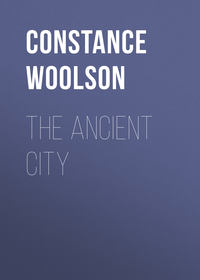 полная версия
полная версияMentone, Cairo, and Corfu
But we shall never see this. In 1889, 180,594 travellers crossed Egypt by way of the Suez Canal. In this item of statistics we have the reason.
THE PYRAMIDSFor those who have fair eyesight the pyramids of Gizeh are a part of Cairo; their gray triangles against the sky are visible from so many points that they soon become as familiar as a neighboring hill. In addition, they have been pictured to us so constantly in paintings, drawings, engravings, and photographs that one views them at first more with recognition than surprise. "There they are! How natural!" And this long familiarity makes one shrink from arranging phrases about them.
One thing, however, can be said: when we are in actual fact under them, when we can touch them, our easy acquaintance vanishes, and we suddenly perceive that we have never comprehended them in the least. The strange geometrical walls effect a spiritual change in us; they free us from ourselves for a moment, and unconsciously we look back across the past to which they belong, and into the future, of which they are a part much more than we are, as unmindful of our own little cares and occupations, and even our own small lives, as though we had never been chained to them. It is but a fleeting second, perhaps, that this mental emancipation lasts, but it is a second worth having!
One drives to the pyramids in an hour, over a macadamized road. The perennial stories about trouble with the Bedouins belong to the past. Soldiers and policemen guard the sands as they guard the Cairo streets, and the proffer of false antiquities is not more pressing, perhaps, than the demands of the beggars in town. These three pyramids of Gizeh are those we think of before we have visited Egypt. But there are others; including the small ones and those which are ruined, seventy have been counted in twenty-five miles from Cairo to Meydoom, and pyramids are to be seen in other parts of Egypt. The stories concerning Gizeh and the travellers who, from Herodotus down, have visited the colossal tombs, are innumerable. I do not know why the one about Lepsius should seem to me amusing. This learned man and his party, who were sent to Egypt by King Frederick William of Prussia in 1842, celebrated that king's birthday by singing in chorus the Prussian national anthem in the centre of Cheops. The Bedouins in attendance reported outside that they had "prayed all together a loud general prayer."
In connection with the pyramids, the English may be said to have devoted themselves principally to measurements. The genius of the French, which is ever that of expression, has invented the one great sentence about them. So far, the Americans have done nothing by which to distinguish themselves; but their time will come, perhaps. One fancies that Edison will have something to do with it. In the meanwhile modernity is already there. There is a hotel at the foot of Cheops, and one hardly knows whether to laugh or to cry when one sees lawn-tennis going on there daily.
But no matter what lies before us – even if they should pave the desert, and establish an English tramway (or a line of American horse-cars) to the Sphinx – these mighty masses cannot be belittled. There is something in the pyramids which overawes our boasted civilization. In their presence this seems trivial; it seems an impertinence.
THE COPTSThe most interesting of the Coptic churches are at Old Cairo, a mother suburb, where the first city was founded by the conquering Arabian army. Here, ensconced amid hill-like mounds of rubbish, concealed behind mud walls, hidden at the end of blind alleys, one finds the temples of these native Christians, who are the descendants of the converts of St. Mark. The exterior walls have no importance. In truth, one seldom sees them, for the churches are within other structures. Some of them form part of old fortified convents; one is reached by passing through the dwelling-rooms of an inhabited house; another is up-stairs in a Roman tower. You arrive somehow at a door. When this is opened, you find yourself in a church whose general aspect is rough, and whose aisles are adorned with dust and sometimes with dirt. But these temples have their treasures. Chief among them are the high choir screens of dark wood, elaborately carved in panels, and decorated with morsels of ivory which have grown yellow from age. The sculpture is not open-work; it does not go through the panel; it is done in relief. The designs are Saracenic, but these geometrical patterns are interrupted every now and then by Christian emblems and by the Coptic cross. The style of this wood-carving is unique; no other sculpture resembles it. If it does not quite attain beauty, it is at least very odd and rich. There are also carved doors representing Scriptural subjects, marble pulpits, singular bronze candlesticks, brass censers adorned with little bells, silver-gilt gospel-cases, embroidered vestments, silver marriage-diadems, ostrich eggs in metal cases, and old Byzantine paintings, often representing St. George, for St. George is the patron saint of the Copts.
These people esteem themselves to be the true descendants of the ancient Egyptians, as distinguished from the conquering race of Arabians who have now overrun their land. It is a comical idea, but they call upon us to note their close resemblance to the mummies. Early converts to Christianity, they have remained faithful to their belief amid the Mohammedan population all about them. It must be mentioned, however, that they had been pronounced heretics by the Council of Chalcedon before the Arabian conquest; for they had refused to worship the human nature of Christ, revering His divine nature alone. They are the guardians of the Christian legends of Egypt. In a crypt under one of their churches they show two niches. One, they say, was the sleeping-place of Joseph, and the other of the Virgin and Child, during the flight into Egypt. Near Heliopolis is an ancient tree, under whose branches the Holy Family are supposed to have rested when the sunshine was too hot for further travelling.
There are between four and five hundred thousand Copts in Egypt. It may be mentioned here that the Christians of the country, including all branches of the faith, number to-day about six hundred thousand, or one-tenth of the population. The Copts are the book-keepers and scribes; they are also the jewellers and embroiderers. Their ancient tongue has fallen into disuse, and is practically a dead language. They now use Arabic, like all the rest of the nation; but the speech survives in their church service, a part of which is still given in the old tongue, though it is said that even the priests themselves do not always understand what they are saying, having merely learned the sentences by heart, so that they can repeat them as a matter of form. Copts have been converted to Protestantism during these latter days by the American missionaries.
They are not, in appearance, an attractive people. Their convents and churches, at least in Cairo and its neighborhood, are so hidden away, inaccessible, and dirty that they are but slightly appreciated by the majority of travellers, who spend far more of their time among the mosques of Mohammed. But both the people and their ancient language are full of interest from an historical point of view. They form a field for research which will give some day rich results. A little has been done, and well done; but much still remains hidden. It has yet to be dug out by the learned. Then it must be translated by the middle-men into those agreeable little histories which, with agreeable little tunes, agreeable little stories, and agreeable little pictures, are the delight of the many.
KIEFThe large modern cafés of Cairo are imitations of the cafés of Paris. They are uninteresting, save that one sees under their awnings, or at the little tables within, the stambouline in all its glory and ugliness – that is, the heavy black frock-coat with stiff collar, which, with the fez or tarboosh, is the appointed costume for all persons who are employed by the government. The stranger, observing the large number of men of all ages in this attire, is led to the conclusion that the government must employ many thousands of persons in Cairo alone; but probably there is a permitted usage in connection with it, like that mysterious legend – "By especial appointment to the Queen" – which one sees so often in England inscribed over the doors of little shops in provincial High Streets, where the inns have names which to Americans are as fantastic as anything in "Tartarin;" the "White Horse;" the "Crab and Lobster;" the "Three Choughs;" and the "Five Alls."
The native cafés have much more local color than the homes of the stambouline. Outside are rows of high wooden settees, upon which the patrons of the establishment sit cross-legged, their slippers left on the ground below. One often sees a row of Arabs squatting here, holding no communication with each other, hearing nothing, seeing nothing, enjoying for the moment an absolute rest. This period of daily repose, called kief, is a necessity for Egyptians. It has its overweight, its excess, in the smoking of hasheesh, which is one of the curses of the land; but thousands of the people who never touch hasheesh would understand as little how to get through their day without this interregnum as without eating; in fact, eating is less important to them.
The Egyptian often takes his rest at the café. When the American sees Achmet and Ibrahim, who have attended to some of his errands for infinitesimal wages – men whose sole possessions are the old cotton gowns on their backs – when he sees them squatted in broad daylight at the café, smoking the long pipes and slowly drinking the Mocha coffee, it appears to him an inexplicable idleness, an incurable self-indulgence. It is idleness, no doubt, but associations should not be mixed with the subject. To the American the little cup of after-dinner coffee seems a luxury. He does not always stop to remember that Achmet's coffee is, very possibly, all the dinner he is to have; that it has been preceded by nothing since daylight but a small piece of Egyptian bread, and that it will be followed by nothing before bedtime but a mouthful of beans or a lettuce-stalk. The daily rest is by no means taken always at the café. Egyptians also take it at the baths, where, after the final douche, they spend half an hour in motionless ease. For those who have not the paras for the café or the bath, the mosques offer their shaded courts. When there is no time to seek another place, the men take their rest wherever they are. One often sees them lying asleep, or apparently asleep, in their booths at the bazaars. The very beggars draw their rags round them, cover their faces, and lie down close to a wall in the crowded lanes.
At the cafés, during another stage of the rest, games are played, the favorites being dominos, backgammon, and chess. Sometimes a story-teller entertains the circle. He narrates the deeds of Antar and legends of adventure; he also tells stories from the Bible, such as the tale of the flood, or of Daniel in the den of lions. Sometimes he recites, in Arabic, the poems of Omar Khayyam.
"I sent my soul through the invisible,Some letter of that after-life to spell;And by-and-by my soul returned to me,And answered, 'I myself am heaven and hell!'"This verse of the Persian poet might be taken as the motto of kief; for if the heaven or hell of each person is simply the condition of his own mind, then if he is able every day to reduce his mind, even for a half-hour only, to a happy tranquillity which has forgotten all its troubles, has he not gained that amount of paradise?
II
"I love the Arabian language for three reasons: because I am an Arab myself; because the Koran is in Arabic; because Arabic is the language of Paradise." This hadith, or saying, of Mohammed might be put upon the banner of the old university of Cairo, El Azhar; that is, the Splendid. El Azhar was founded in the tenth century, when Cairo itself was hardly more than a name. In its unmoved attachment to the beliefs of its founders, to their old enthusiasms, their methods and hates, El Azhar has opposed an inflexible front to the advance of European ideas, sending out year after year its hundreds of pupils to all parts of Egypt and to Nubia, to the Soudan and to Morocco, to Turkey, Arabia, and Syria, to India and Ceylon, and to the borders of Persia, believing that so long as it could keep the education of the young in its grasp the reign of the Prophet was secure. It is to-day the most important Mohammedan college in the world; for though it has no longer the twenty thousand students who crowded its courts in the thirteenth and fourteenth centuries, there is still an annual attendance of from seven to ten thousand; by some authorities the number is given as twelve thousand. The twelve thousand have no academic groves; they have not even one tree. There is nothing sequestered about El Azhar; it is near the bazaars in the old part of the town, where the houses are crowded together like wasps' nests. One sees nothing of it as one approaches save the minarets above, and in the narrow, crowded lane an outer portal. Here the visitor must show his permit and put on the mosque-shoes, for El Azhar was once a mosque, and is now mosque and university combined. After the shoes are on he steps over the low bar, and finds himself within the porch, which is a marvel as it stands, with its fretwork, carved stones, faded reds, and those old plaques of inscription which excite one's curiosity so desperately, and which no dragoman can ever translate, no matter in how many languages he can complacently ask, "You satisfi?" One soon learns something of the older tongue; hieroglyphics are not difficult; any one with eyes can discover after a while that the A of the ancient Egyptians is, often, a bird who bears a strong resemblance to a pigeon; that their L is a lion; and that the name of the builder of the Great Pyramid, for instance, is represented by a design which looks like two freshly hatched chickens, a football, and a horned lizard (speaking, of course, respectfully of them all). But one can never find out the meaning of the tantalizing characters, so many thousand years nearer our own day, which confront us, surrounded by arabesques, over old Cairo gateways, across the fronts of the street fountains, or inscribed in faded gilt on the crumbling walls of mosques. It is probable that they are Kufic, and one would hardly demand, I suppose, that an English guide should read black-letter? But who can be reasonable in the land of Aladdin's Lamp?
The porch leads to the large central court, which is open to the sky, the breeze, and the birds; and this last is not merely a possibility, for birds of all kinds are numerous in Egypt, and unmolested. On the pavement of this court, squatting in groups, are hundreds of the turbaned students, some studying aloud, some reading aloud (it is always aloud), some listening to a professor (who also squats), some eating their frugal meals, some mending their clothes, and some merely chatting. These groups are so many and so close together that often the visitor can only make the circuit of the place on its outskirts; he cannot cross. There is generally a carrier of drinking-water making his rounds amid the serried ranks. "For whoever is thirsty, here is water from God," he chants. One is almost afraid to put down the melodious phrase, for the street cries of Cairo have become as trite as the Ranz des Vaches of Switzerland. Still, some of them are so imaginative and quaint that they should be rescued from triteness and made classic. Here is one which is chanted by the seller of vegetables – the best beans, it should be explained, come from Embebeh, beyond Boulak – "Help, O Embebeh, help! The beans of Embebeh are better than almonds. Oh-h, how sweet are the little sons of the river!" (This last phrase makes poetical allusion to the soaking in Nile water, which is required before the beans can be cooked.) Certain famous baked beans nearer home also require preliminary soaking. Let us imagine a huckster calling out in Boston streets, as he pursues his way: "Help, O Beverly, help! The beans of Beverly are better than peaches. Oh-h, how sweet are the little sons of Cochituate!"
The central court of the Splendid is surrounded by colonnades, whose walls are now undergoing repairs; but the propping beams do not appear to disturb either the pupils or teachers. On the east side is the sanctuary, which is also a school-room, but a covered one; it is a large, low-ceilinged hall, covering an area of thirty-six hundred square yards; by day its light is dusky; by night it is illuminated by twelve hundred twinkling little lamps suspended from the ceiling by bronze chains. The roof is supported by three hundred and eighty antique columns of marble and granite placed in irregular ranges; there are so many of these pillars that to be among them is like standing in a grove. The pavement is smoothly covered with straw matting; and here also are assembled throngs of pupils – some studying, some reciting, some asleep. I paid many visits to El Azhar, moving about quietly with my venerable little dragoman, whom I had selected for an unusual accomplishment – silence. One day I came upon an arithmetic class; the professor, a thin, ardent-eyed man of forty, was squatted upon a beautiful Turkish rug at the base of a granite column; his class of boys, numbering thirty, were squatted in a half-circle facing him, their slates on the matting before them. The professor had a small black-board which he had propped up so that all could see it, and there on its surface I saw inscribed that enemy of my own youth, a sum in fractions – three-eighths of seven-ninths of twelve-twentieths of ten-thirty-fifths, and so on; evidently the terrible thing is as savage as ever! The professor grew excited; he harangued his pupils; he did the sum over and over, rubbing out and rewriting his ferocious conundrum with a bit of chalk. Slender Arabian hands tried the sum furtively on the little slates; but no one had accomplished the task when, afraid of being remarked, I at last turned away.
The outfit of a well-provided student at El Azhar consists of a rug, a low desk like a small portfolio-easel, a Koran, a slate, an inkstand, and an earthen dish. Instruction is free, and boys are admitted at the early age of eight years. The majority of the pupils do not remain after their twelfth or fourteenth year; a large number, however, pursue their studies much longer, and old students return from time to time to obtain further instruction, so that it is not uncommon to see a gray-bearded pupil studying by the side of a child who might be his grandson. To me it seemed that two-thirds of the students were men between thirty and forty years of age; but this may have been because one noticed them more, as collegians so mature are an unusual sight for American eyes.
All the pupils bow as they study, with a motion like that of the bowing porcelain mandarins. The custom is attributed to the necessity for bending the head whenever the name of Allah is encountered; as the first text-book is always the Koran, children have found it easier to bow at regular intervals with an even motion than to watch for the numerous repetitions of the name. The habit thus formed in childhood remains, and one often sees old merchants in the bazaars reading for their own entertainment, and bowing to and fro as they read. I have even beheld young men, smartly dressed in full European attire, who, lost in the interest of a newspaper, had forgotten themselves for the moment, and were bending to and fro unconsciously at the door of a French café. A nation that enjoys the rocking-chair ought to understand this. Some of the students of El Azhar have rooms outside, but many of them possess no other shelter than these two courts, where they sleep upon their rugs spread over the matting or pavement. Food can be brought in at pleasure, but those two Oriental time-consumers, pipes and coffee, are not allowed within the precincts. In one of the porches barbers are established; there is generally a row of students undergoing the process of head-shaving. The fierce, fanatical blind pupils, so often described in the past by travellers, are no longer there; the porter can show only their empty school-room. Blindness is prevalent in Egypt; no doubt the sunshine of the long summer has something to do with it, but another cause is the neglected condition of young children. There is no belief so firmly established in the minds of Egyptian mothers as the superstition that the child who is clean and well-dressed will inevitably attract the dreaded evil-eye, and suffer ever afterwards from the effects of the malign glance. I have seen women who evidently belonged to the upper ranks of the middle class – women dressed in silk, with gold ornaments, and a following servant – who were accompanied by a poor baby of two or three years of age, so dirty, so squalid and neglected, that any one unacquainted with the country would have supposed it to be the child of a beggar.
In addition to the bowing motion, instruction at El Azhar is aided by a mnemonic system, the rules of grammar, and other lessons also, being given in rhyme. I suppose our public schools are above devices of this sort; but there are some of us among the elders who still fly mentally, when the subject of English history comes up, to that useful poem beginning "First, William the Norman;" and I have heard of the rules for the use of "shall" and "will" being properly remembered only when set to the tune of "Scotland's burning!" Surely any tune – even "Man the Life-boat" – would become valuable if it could clear up the bogs of the subjunctive.
It must be mentioned that El Azhar did not invent its mnemonics; it has inherited them from the past. All the mediæval universities made use of the system.
The central court is surrounded on three sides by chambers, one of which belongs to each country and to each Egyptian province represented at the college. These sombre apartments are filled with oddly-shaped wardrobes, which are assigned to the students for their clothes. There is a legend connected with these rooms: At dusk a man whose heart is pure is sometimes permitted to see the elves who come at that hour to play games in the inner court under the columns; here they run races, they chase each other over the matting, they climb the pillars, and indulge in a thousand antics. The little creatures are said to live in the wardrobes, and each student occasionally places a few flowers within, to avert from himself the danger that comes from their too great love of tricks. There are other inhabitants of these rooms who also indulge in tricks. These are little animals which I took to be ferrets; twice I had a glimpse of a disappearing tail, like a dark flash, as I passed over a threshold. Probably they are kept as mouse-hunters, for pets are not allowed; if they were, it would be entertaining to note those which would be brought hither by homesick pupils from the Somali coast, or Yemen.
In beginning his education the first task for a boy is to commit the Koran to memory. As he learns a portion he is taught to read and to write those paragraphs; in this way he goes through the entire volume. Grammar comes next; at El Azhar the word includes logic, rhetoric, composition, versification, elocution, and other branches. Then follows law, secular and religious. But the law, like the logic, like all the instruction, is founded exclusively upon the Koran. As there is no inquiry into anything new, the precepts have naturally taken a fixed shape; the rules were long ago established, and they have never been altered; the student of 1890 receives the information given to the student of 1490, and no more. But it is this very fact which makes El Azhar interesting to the looker-on; it is a living relic, a survival in the nineteenth century of the university of the fourteenth and fifteenth. It is true that when we think of those great colleges of the past, the picture which rises in the mind is not one of turbaned, seated figures in flowing robes; it is rather of aggressively agile youths, with small braggadocio caps perched on their long locks, their slender waists outlined in the shortest of jackets, and their long legs incased in the tightest of party-colored hose. But this is because the great painters of the past have given immortality to these astonishing scholars of their own lands by putting them upon their canvases. They confined themselves to their own lands too, unfortunately for us; they did not set sail, with their colors and brushes, upon Homer's "misty deep." It would be interesting to see what Pinturicchio would have made of El Azhar; or how Gentile da Fabriano would have copied the crowded outer court.











